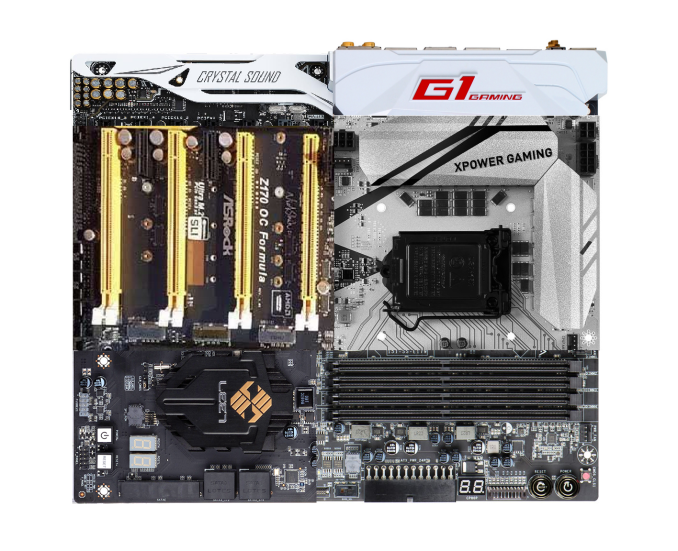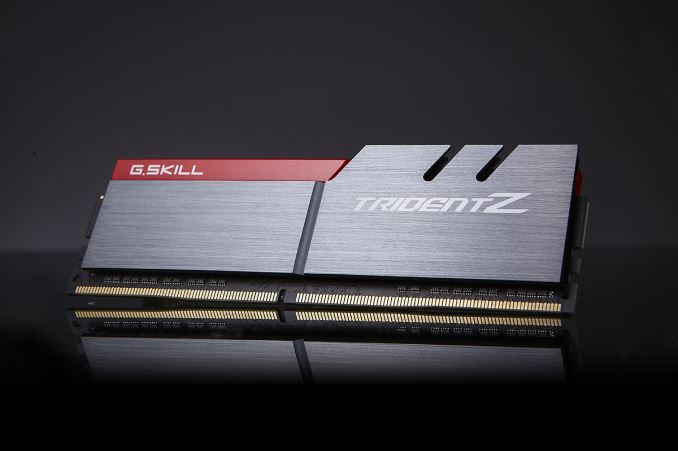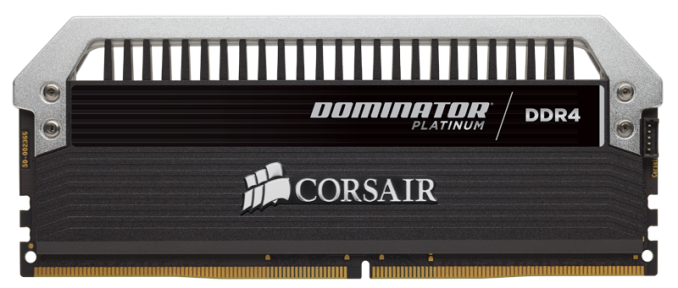The Intel 6th Gen Skylake Review: Core i7-6700K and i5-6600K Tested
by Ian Cutress on August 5, 2015 8:00 AM ESTAlso Launching Today: Z170 Motherboards, Dual Channel DDR4 Kits
The new Skylake processors are assigned a new socket – LGA1151. Intel’s policy since 2006 has been to maintain sockets for two generations and as a result moving from Broadwell to Skylake we were expecting the change. This means that Skylake processors will not work in LGA1150 based motherboards, i.e. those with Intel’s 8th and 9th generation chipsets. For Skylake we get the 100-series chipsets with additional functionality. Launching today in turn is the first member of the 100-series family, the overclocking-friendly Z170, with the other chipsets in the family to follow later in the year.
We have a large piece on the motherboards being released or talked about for Skylake, covering some 55+ products and the different variations within. The major motherboard manufacturers such as ASUS, GIGABYTE, ASRock, MSI, EVGA and a couple of others should all have a wide range ready to purchase on day one, although some models may be region specific.

The badly MSPaint’ed hybrid: MSI’s XPower Gaming Socket, GIGABYTE’s G1 Gaming IO panel, EVGA’s DRAM slots, ECS’s chipset, ASRock’s PCIe arrangement and ASUS’ Deluxe audio.
Here’s an amalgamation of some of the designs coming to end users, with almost all of them investing heavily in gaming brands with specific components to aid the user experience while gaming. Aesthetic designs are also going to be a focus of this generation, with some of the manufacturers moving into a different direction with their designs and trying some new color schemes. Some basic looking models will also be available.
Prices for Z170 motherboards will range from $80 all the way past $400+, depending on feature set and size. A number of motherboards above $150 will feature a couple USB 3.1 Gen 2 (10Gbps) ports, although you will have to check whether they are Type-A or Type-C. That being said, most motherboards with USB 3.1 will use both, but there are a select few that are C-only or A-only. Also over $150 we will see a lot of Intel’s new network controller, the I219-V, although the gaming lines might invest in Rivet Network’s Killer solution instead.
Intel is launching the Alpine Ridge controller at this time as well, which is said to support USB 3.1 Gen 2, Thunderbolt 3, HDMI 2.0, DisplayPort, and DockPort. According to our sources it would seem that GIGABYTE currently has an exclusive on this technology, and it will be used for their USB 3.1 Gen 2 ports on most motherboard models. Other functionality from the Alpine Ridge controller (TB3, HDMI 2.0) will be on a case-by-case basis depending on how the controller works in two different modes or if extra components are used. We are told that Alpine Ridge costs similarly to the ASMedia ASM1142 controller, but will enable two USB 3.1 Gen 2 ports at 10 Gbps simultaneously as it uses four PCIe lanes from the chipset.
We will go more into the 100-series chipset in the next page, but it is worth mentioning briefly here that the speed between the CPU and the chipset has increased from DMI 2.0 (5 GT/s, 2GB/sec) to DMI 3.0 (8 GT/s, 3.93GB/sec), and that the chipset has a new high speed hub (HSIO) that allows 26 lanes to be used from it although some lanes are limited (e.g. 20 PCIe 3.0 lanes maximum split into five x4 controllers). Intel’s Rapid Storage Technology is upgraded as well to give three PCIe drives access to its features as long as they are on the correct HSIO ports.
DRAM: The March to DDR4
In the world of DRAM for personal computers, DDR3 is currently king. Having been the main standard since 2007, you would be hard pressed to find a mainstream or low end platform sold that did not require access to DDR3. That changed in the enthusiast segment last year with the launch of Haswell-E which also introduced DDR4 at a high premium. For Haswell-E there was no crossover – you had no choice but to use DDR4 (unless you might be a million-unit customer).
Because the consumers and consumer product OEMs are more price sensitive, DDR4 will be a slower transition. There is precedent here in that the move from DDR2 to DDR3 saw a generation of processors that supported both standards and it was up to the motherboard manufacturer to design for it. In this transition, Skylake processors will support both DDR3L and DDR4 modules, with a few caveats.
Caveat number one is that initially, only DDR4 motherboards will be on the market. So if you upgrade now, DDR4 needs to be on the shopping list as well. We have had word of some DDR3L-only motherboards coming, as well as combo boards with DDR3L and DDR4 slots on board. Caveat one-point-five, you can use either DDR3L or DDR4, but not both at the same time.
Caveat number two, DDR3L is different to DDR3 as it operates at a lower voltage. This means that the memory controllers on Skylake most likely have a combined voltage domain, and regular DDR3 might not work (in fact early testing suggests not without reducing the voltage). Very few people currently own DDR3L DIMMs, so the likelihood of a user performing an upgrade while reusing their RAM might be slim.
Caveat number three: prices of DDR4 have dropped significantly since last year, and there is only a small premium over DDR3. The benefits of DDR4 include a lower operating voltage, a more stable design, and the ability to purchase 16GB modules with ease. That means that a Skylake platform will happily take 64GB of memory.
With that last point, we should point out that Skylake is a dual memory channel architecture, supporting two memory modules per channel. This gives a maximum of four DDR4 tests, and 4x16 = 64GB maximum.
We have been told that Skylake’s memory controller, compared to previous generations, is absolutely golden at higher speed memory support. By default Skylake supports the JEDEC standard for DDR4, 2133 MT/s at a latency of 15-15-15, but the overclocking guides we have received suggests that all processors should be able to reach DDR4-3200 relatively comfortably, with a few processors in the right motherboards going for DDR4-4000. While this should bode well for integrated graphics users, those high end kits are typically very expensive.
We currently have dual channel kits in to test from a number of the DRAM companies, and plan on performing a memory scaling article within the next few weeks to see how exactly performance might scale on Skylake. Though in the meantime, as part of this review, we were able to source a closed beta variant of a combination DDR3L/DDR4 motherboard for Skylake and have included a test comparing the two.












477 Comments
View All Comments
janolsen - Thursday, August 6, 2015 - link
Great review, both on details and timeliness :)Strange that graphics are slower. Why did Intel chose to downgrade the GPU from Broadwell, scrapping it makes a tiny percentage in overall CPU speed?
And discrete graphics are surprisingly is also slowed down by the new CPU/chipset.
No great reason to upgrade it seems...at least not for gamers.
HollyDOL - Thursday, August 6, 2015 - link
Few points...1. I think testing with Windows 7 is quite outdated, there seems to be benchmarks hinting there are interesting performance gains with Skylake+Windows 10... It needs to be checked out imo
2. It also seems DDR4-2133 gives quite lousy numbers. Where the difference is noticable, it looks like DDR4-3000ish seems to hit the sweet spot
3. There are decent chances performance will grow up yet with new firmware and or compiler versions. Alas, there is no doubt current numbers are such we can see.
4. Absence of decent graphics (5775C ish) seems to be like a step down for me. Either I would like to have absolutely no silicon wasted on never used graphics or have one that I can use for usual good old "DirectX 9" or older gaming without need to kick in dGPU.
5. There are definitely improvements but atm nothing that big that would make me upgrade to new platform (CPU+MOBO+RAM+GPU+NVMe SSD) to make it worth it (atm 2500K). Guess Kaby Lake and HBM2 nVidia could make it worth it.
6. Thanks Ian for exhaustive review.
Bambooz - Friday, August 7, 2015 - link
"Let's jump on the Windows 10 bandwagon and leave a solid OS that never caused problems like their so-called successors ( http://www.extremetech.com/computing/164209-window... ) behind for no good reason"mycrobe - Thursday, August 6, 2015 - link
It's interesting to speculate that Intel put so much effort into improving 14nm yield for Skylake that they scaled back on improvements to the core outside of the GPU and memory interface.Perhaps Skylake is somewhere between a tick and a tock. Call it a "tück".
Implicit in that statement is the hope that the real 14nm tock will be Kaby Lake.
versesuvius - Thursday, August 6, 2015 - link
"There’s no easy way to write this."Why? Are you having an AMD Flagship GPU moment with almighty Intel? Is that eating into the fabric of the universe as you know it?
zlandar - Thursday, August 6, 2015 - link
After looking at other reviews of Skylake I'll give props to Ian for including a Sandy Bridge processor in his review. Many of the other reviews don't include SB which is a glaring omission since many PC users still use one in their main rig.I still disagree with the assertion SB is "dead" or there is a "compelling" reason to move from SB to Skylake.
It's not that Skylake is bad or mediocre. It's just not the evolutionary jump that Sandy Bridge was from the 1st gen Core processors. When you ask people to replace a motherboard and RAM for a new processor the expectations are higher.
superjim - Friday, August 21, 2015 - link
"It's not that Skylake is bad or mediocre. It's just not the evolutionary jump that Sandy Bridge was from the 1st gen Core processors. When you ask people to replace a motherboard and RAM for a new processor the expectations are higher."This should have been on the conclusions page and sums up how I feel about SL.
eSyr - Thursday, August 6, 2015 - link
"But it is worth remembering that these tests are against a memory clock of 2133 MHz, whereas the others are at 1866 MHz. As a result, the two lines are more or less equal in terms of absolute time, as we would expect." — but latency graph is in CPU clock cycles, isn't it? And, as a consequence, these graphs should be directly comparable (and DDR4 has bigger latency in absolute time), shouldn't they?8steve8 - Thursday, August 6, 2015 - link
when can we actually buy this? the 5775c isn't even for sale yet here in the USAFruitn - Thursday, August 6, 2015 - link
We have in Denmark. Both the 5775c, 6600K, 6700K :)